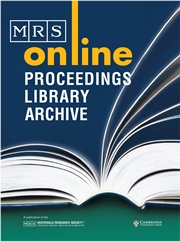Article contents
First-principles Investigations of Point Defect Behavior and Elastic Properties of TiNi Based Alloys
Published online by Cambridge University Press: 01 February 2011
Abstract
First-principles calculations by the use of a plane-wave pseudopotential method are performed to investigate intrinsic point defect behavior in TiNi. The results show that TiNi is an antisite type intermetallic compound. The calculated interaction energies between the point defects demonstrate that Ti antisites are attractive to each other whereas Ni antisites are mutually repulsive. The attraction between Ti antisites indicates that excess Ti in TiNi may agglomerate so that a Ti-rich phase can easily precipitate. The repulsion between Ni antisites implies that the excess Ni is of certain solubility in TiNi. This result explains well the asymmetric feature of TiNi field on the binary phase diagram. In order to understand the correlation between the composition dependent elastic modulus and martensitic transformation (MT) temperature, the elastic moduli critical to MT, i.e., c′ and c44, are calculated as a function of the composition of the off-stoichiometric TiNi and a series of ternary TiNi-X alloys, by the use of exact muffin-tin orbital method in combination with coherent potential approximation. It turns out that, generally speaking, the early transition metal (TM) alloying elements in the periodic table increase c′ but decrease c44; the middle ones increase both c′ and c44, whereas the late ones decrease c′ but increase c44. An examination of the theoretical composition dependent elastic modulus and the experimental MT temperature shows that the MT temperature is more sensitive to the variation of c44 than to that of c′.
- Type
- Research Article
- Information
- Copyright
- Copyright © Materials Research Society 2009
References
REFERENCES
- 2
- Cited by


